
|
Now it is not observable. It will appear in the morning sky again at 13-14 mag in August.
Date(TT) R.A. (2000) Decl. Delta r Elong. m1 Best Time(A, h)
May 11 3 36.24 17 17.2 3.039 2.038 6 12.6 20:29 (123,-14)
May 18 3 53.31 18 1.7 3.055 2.048 4 12.7 20:37 (127,-16)
|
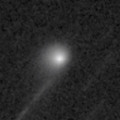
|
Appearing in the morning sky in the Southern Hemisphere. It will appear in the morning sky in late June in the Northern Hemisphere. It will brighten up to 10.5 mag and it will be observable in good condition from autumn to winter.
Date(TT) R.A. (2000) Decl. Delta r Elong. m1 Best Time(A, h)
May 11 2 2.49 -2 20.8 4.472 3.591 25 12.8 3:23 (259,-19)
May 18 2 7.39 -0 52.8 4.400 3.559 29 12.7 3:15 (260,-15)
|

|
It brightened up to 7.7 mag in June in 2018 (June 19, Juan Jose Gonzalez). Now it is fading. But it is still bright as 12.9 mag (May 6, Chris Wyatt). In the Southern Hemisphere, it stays observable for a long time until the comet will fade out. In the Northern Hemisphere, it is not observable for a long time until autumn when the comet fades out down to 16 mag.
Date(TT) R.A. (2000) Decl. Delta r Elong. m1 Best Time(A, h)
May 11 5 21.47 -36 52.0 4.068 3.716 62 12.9 20:29 ( 61,-24)
May 18 5 29.75 -35 21.3 4.159 3.773 60 13.1 20:37 ( 65,-28)
|
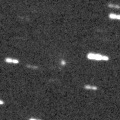
|
Now it is bright as 13.5 mag (May 7, Thomas Lehmann). It stays 13 mag for a long time in 2019. In the Southern Hemisphere, it is observable in excellent condition. In the Northern Hemisphere, it is not observasble until summer in 2020.
Date(TT) R.A. (2000) Decl. Delta r Elong. m1 Best Time(A, h)
May 11 7 25.18 -53 38.2 2.904 3.071 89 13.1 20:29 ( 34,-15)
May 18 7 24.55 -52 59.5 2.934 3.060 87 13.1 20:37 ( 38,-19)
|

|
It approached to Earth down to 0.3 a.u. in mid February, and brightened up to 5.5 mag (Feb. 13, Juan Jose Gonzalez). Now it is fading. It has already faded down to 13.0 mag (Apr. 24, M. Lehky). In the Southern Hemisphere, it is not observable now. It will be unobservable soon also in the Northern Hemisphere.
Date(TT) R.A. (2000) Decl. Delta r Elong. m1 Best Time(A, h)
May 11 4 29.68 33 59.7 2.739 1.865 24 13.2 20:29 (128, 6)
May 18 4 31.92 34 15.6 2.860 1.934 19 13.6 20:37 (133, 1)
|

|
Now it is 12.8 mag (May 8, Chris Wyatt). It stays 13-14 mag until summer. It is observable in excellent condition in the Southern Hemisphere. In the Northern Hemisphere, it will be getting lower gradually, and it will be unobservable in July.
Date(TT) R.A. (2000) Decl. Delta r Elong. m1 Best Time(A, h)
May 11 16 7.30 -39 21.8 2.483 3.424 154 13.3 0:56 ( 0, 16)
May 18 15 48.32 -40 45.9 2.484 3.445 158 13.3 0:10 ( 0, 14)
|

|
Appearing in the morning sky.
Date(TT) R.A. (2000) Decl. Delta r Elong. m1 Best Time(A, h)
May 11 0 29.40 10 19.1 6.512 5.768 39 13.8 3:23 (262, 7)
May 18 0 33.85 10 55.3 6.441 5.768 44 13.8 3:15 (264, 11)
|
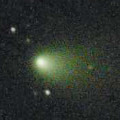
|
Now it is 13.4 mag (May 6, Chris Wyatt). It is observable in excellent condition in the Northern Hemisphere. It locates somewhat low in the Southern Hemisphere.
Date(TT) R.A. (2000) Decl. Delta r Elong. m1 Best Time(A, h)
May 11 11 8.50 20 18.0 1.700 2.252 109 14.1 20:29 ( 30, 73)
May 18 11 13.36 18 30.8 1.787 2.270 105 14.3 20:37 ( 46, 68)
|
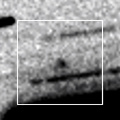
|
Now it is bright as 13.4 mag (May 10, Katsumi Yoshimoto). It brightens up to 13-14 mag from May to June. However, it locates very low in the Northern Hemisphere. It is not observable in the Southern Hemisphere.
Date(TT) R.A. (2000) Decl. Delta r Elong. m1 Best Time(A, h)
May 11 1 54.28 55 41.3 1.951 1.354 40 14.3 3:23 (214, 19)
May 18 2 47.80 58 32.4 1.928 1.326 40 14.2 3:15 (209, 17)
|

|
It is expected to brighten up to 7 mag in 2020. Now it is not observable. It will appear in the morning sky in July.
Date(TT) R.A. (2000) Decl. Delta r Elong. m1 Best Time(A, h)
May 11 3 42.22 10 13.3 5.488 4.501 10 14.4 20:29 (117,-18)
May 18 3 47.83 11 0.6 5.433 4.437 8 14.3 20:37 (123,-23)
|

|
It stays 15 mag from 2018 to 2019, and it will be observable for a long time in the Southern Hemisphere. In the Northern Hemisphere, it will never be observable again. It has not been observed since last October.
Date(TT) R.A. (2000) Decl. Delta r Elong. m1 Best Time(A, h)
May 11 0 4.28 -46 17.6 4.127 4.011 76 14.8 3:23 (313,-20)
May 18 0 10.49 -45 49.6 4.072 4.025 80 14.8 3:15 (314,-17)
|
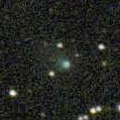
|
It is expected to brighten up to 10 mag in autumn. Now it is 15.1 mag (May 5, Thomas Lehmann). In the Northern Hemisphere, it stays observable for a long time while the comet is brightening. In the Southern Hemisphere, it it not observable until mid September.
Date(TT) R.A. (2000) Decl. Delta r Elong. m1 Best Time(A, h)
May 11 3 47.01 68 14.7 2.661 2.171 50 15.0 20:29 (159, 23)
May 18 3 54.29 66 48.8 2.651 2.105 47 14.8 20:37 (160, 20)
|
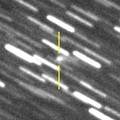
|
Now it is 14.8 mag (May 10, Katsumi Yoshimoto). It brightens up to 15 mag from May to June, and it will be observable in good condition.
Date(TT) R.A. (2000) Decl. Delta r Elong. m1 Best Time(A, h)
May 11 22 3.70 22 11.4 1.580 1.578 71 15.0 3:23 (272, 43)
May 18 22 22.98 25 36.4 1.571 1.580 71 15.0 3:15 (267, 45)
|

|
Now it is 14.2 mag (May 7, Thomas Lehmann). It will be fading after this. In the Southern Hemisphere, it stays observable for a long time until it fades out. In the Northern Hemisphere, it will not be observable after this.
Date(TT) R.A. (2000) Decl. Delta r Elong. m1 Best Time(A, h)
May 11 5 45.70 -19 52.1 4.524 4.009 53 15.2 20:29 ( 73,-11)
May 18 5 49.27 -20 4.4 4.617 4.059 51 15.3 20:37 ( 77,-17)
|

|
Now it is 15.9 mag (May 4, Toshihiko Ikemura, Hirohisa Sato). It will be fading slowly after this. It is observable in good condition in the Northern Hemisphere. In the Southern Hemisphere, it stays extremely low for a while.
Date(TT) R.A. (2000) Decl. Delta r Elong. m1 Best Time(A, h)
May 11 15 14.57 47 20.4 3.974 4.494 114 15.3 0:03 (180, 78)
May 18 15 7.71 46 36.3 4.045 4.546 113 15.4 23:23 (180, 79)
|

|
Now it is 16.1 mag (Apr. 27, Toshihiko Ikemura, Hirohisa Sato). It will be fading slowly after this. It is observable in excellent condition until spring in the Northern Hemispehre. In the Southern Hemisphere, it will be hardly observable after this.
Date(TT) R.A. (2000) Decl. Delta r Elong. m1 Best Time(A, h)
May 11 8 44.74 36 48.2 5.521 5.344 74 15.7 20:29 (106, 54)
May 18 8 44.07 35 57.7 5.676 5.385 68 15.8 20:37 (107, 47)
|
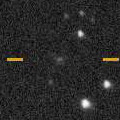
|
It stays 16 mag for a long time from 2019 to 2020. It is observable in excellent condition in the Southern Hemisphere. It is hardly observable in the Northern Hemisphere.
Date(TT) R.A. (2000) Decl. Delta r Elong. m1 Best Time(A, h)
May 11 11 48.52 -57 58.8 3.256 3.929 125 16.0 20:32 ( 0, -3)
May 18 11 34.77 -57 29.0 3.269 3.899 121 16.0 20:37 ( 6, -3)
|

|
Now it is 16.4 mag (May 2, Toshihiko Ikemura, Hirohisa Sato). It will brighten rapidly after this. It will be observable at 13.5 mag in good condition in autumn.
Date(TT) R.A. (2000) Decl. Delta r Elong. m1 Best Time(A, h)
May 11 17 50.97 -6 50.9 1.665 2.517 139 16.3 2:39 ( 0, 48)
May 18 17 50.02 -6 4.8 1.576 2.474 145 16.1 2:10 ( 0, 49)
|

|
It brightened up to 14 mag from autumn to winter in 2018. Now it is fading. It is observable in excellent condition in the Northern Hemisphere. It locates extremely low in the Southern Hemisphere.
Date(TT) R.A. (2000) Decl. Delta r Elong. m1 Best Time(A, h)
May 11 9 57.32 47 50.6 2.599 2.700 84 16.1 20:29 (131, 67)
May 18 10 4.70 45 16.0 2.711 2.742 81 16.2 20:37 (122, 63)
|
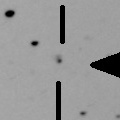
|
Asteroid, but it brightened rapidly. It is observable in excellent condition in the Southern Hemisphere. It is hardly observable in the Northern Hemisphere.
Date(TT) R.A. (2000) Decl. Delta r Elong. m1 Best Time(A, h)
May 11 22 26.38 -36 59.7 6.462 6.472 86 16.4 3:23 (317, 0)
May 18 22 24.49 -37 23.3 6.339 6.466 92 16.3 3:15 (321, 3)
|
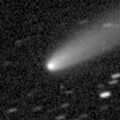
|
It brightened up to 13.2 mag from December to March (Dec. 30, Chris Wyatt). Now it is fading. It has already faded down to 16.6 mag (May 3, Toshihiko Ikemura, Hirohisa Sato). It will be fainter than 18 mag in June.
Date(TT) R.A. (2000) Decl. Delta r Elong. m1 Best Time(A, h)
May 11 11 30.12 -2 24.5 1.416 2.152 124 16.4 20:29 ( 6, 52)
May 18 11 35.30 -2 36.3 1.518 2.192 118 16.7 20:37 ( 18, 51)
|
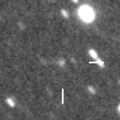
|
It will brighten up to 16.5 mag in June. It is observable in excellent condition in the Southern Hemisphere. It locates low in the Northern Hemisphere. It has not been observed since last October.
Date(TT) R.A. (2000) Decl. Delta r Elong. m1 Best Time(A, h)
May 11 18 8.91 -35 25.2 2.992 3.789 136 16.7 2:57 ( 0, 20)
May 18 17 54.27 -36 55.6 2.896 3.771 145 16.6 2:15 ( 0, 18)
|

|
Now it is 17.3 mag (May 4, Toshihiko Ikemura, Hirohisa Sato). It stays 16-17 mag for a long time until 2020. It is observable in good condition in the Northern Hemisphere. It is not observable at all in the Southern Hemisphere.
Date(TT) R.A. (2000) Decl. Delta r Elong. m1 Best Time(A, h)
May 11 10 47.42 69 23.7 8.544 8.457 81 16.8 20:29 (171, 55)
May 18 10 48.46 68 33.3 8.606 8.459 78 16.8 20:37 (166, 54)
|

|
Now it is 16.4 mag (May 7, Toshihiko Ikemura, Hirohisa Sato). It is observable at 17 mag in good condition in 2019. It locates somewhat low in the Northern Hemisphere.
Date(TT) R.A. (2000) Decl. Delta r Elong. m1 Best Time(A, h)
May 11 15 37.98 -15 51.7 2.863 3.868 172 16.9 0:26 ( 0, 39)
May 18 15 33.27 -15 43.3 2.866 3.876 176 16.9 23:49 ( 0, 39)
|

|
It approached to Earth down to 0.08 a.u. in mid December, and it brightened up to 3.4 mag (Dec. 14, Seiichi Yoshida). it looked so large as 3 times of Moon. Now it is fading. It has already faded down to 17.6 mag (Apr. 27, Toshihiko Ikemura, Hirohisa Sato). In the Northern Hemisphere, it stays observable in excellent condition. It locates low in the Southern Hemisphere.
Date(TT) R.A. (2000) Decl. Delta r Elong. m1 Best Time(A, h)
May 11 10 42.25 24 29.9 1.591 2.060 102 16.9 20:29 ( 55, 73)
May 18 10 50.66 22 45.9 1.719 2.118 98 17.4 20:37 ( 63, 67)
|

|
Now it is 16.6 mag (May 3, Toshihiko Ikemura, Hirohisa Sato). It is expected to be observable at 5-6 mag for a long time from 2022 to 2023. In the Northern Hemisphere, it is not observable at the highlight from 2022 summer to 2023 summer. In the Southern Hemisphere, it stays unobservable for a while. But it will be observable in good condition at the highlight.
Date(TT) R.A. (2000) Decl. Delta r Elong. m1 Best Time(A, h)
May 11 18 3.23 58 0.3 11.550 11.703 96 17.0 2:50 (180, 67)
May 18 17 59.77 58 17.0 11.492 11.657 96 17.0 2:19 (180, 67)
|
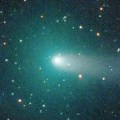
|
It brightened up to 9.5 mag from autumn to winter (Dec. 14, Marco Goiato). Now it is fading. It has already faded down to 16.2 mag (Apr. 27, Toshihiko Ikemura, Hirohisa Sato). In the Northern Hemisphere, it stays observable in good condition for a long time until it fades out. It locates low in the Southern Hemispehre.
Date(TT) R.A. (2000) Decl. Delta r Elong. m1 Best Time(A, h)
May 11 9 42.97 34 8.8 2.521 2.664 86 17.1 20:29 ( 96, 65)
May 18 9 52.20 32 49.8 2.661 2.724 82 17.5 20:37 ( 96, 59)
|
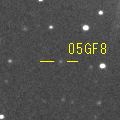
|
First return of a new periodic comet which brightened up to 16.5 mag in 2005. Now it is 17.6 mag (May 9, Toshihiko Ikemura, Hirohisa Sato). It stays 17.5 mag until early summer.
Date(TT) R.A. (2000) Decl. Delta r Elong. m1 Best Time(A, h)
May 11 12 51.43 -7 14.4 2.129 3.012 144 17.4 21:36 ( 0, 48)
May 18 12 49.88 -7 3.2 2.169 2.995 137 17.4 21:07 ( 0, 48)
|

|
Now it is 17.2 mag (May 4, Toshihiko Ikemura, Hirohisa Sato). Fading slowly. It stays observable at 17 mag in good condition until summer.
Date(TT) R.A. (2000) Decl. Delta r Elong. m1 Best Time(A, h)
May 11 11 27.13 10 48.4 9.615 10.132 118 17.5 20:29 ( 10, 65)
May 18 11 27.14 10 53.0 9.731 10.145 111 17.5 20:37 ( 30, 63)
|

|
Now it is 18.7 mag (May 7, Martin Masek). It will brighten rapidly up to 11.5 mag in autumn. In the Northern Hemisphere, it will be observable in excellent condition. In the Southern Hemisphere, it will be extremely low from autumn to winter.
Date(TT) R.A. (2000) Decl. Delta r Elong. m1 Best Time(A, h)
May 11 22 21.35 -24 17.6 1.792 1.926 81 17.9 3:23 (310, 10)
May 18 22 37.04 -22 48.3 1.686 1.880 84 17.5 3:15 (309, 12)
|

|
In the Southern Hemisphere, it is observable at 17.5 mag in good condition from spring to summer. In the Northern Hemisphere, it is not observable at all. It has not been observed since last September.
Date(TT) R.A. (2000) Decl. Delta r Elong. m1 Best Time(A, h)
May 11 17 6.12 -57 1.3 3.617 4.390 135 17.7 1:55 ( 0, -2)
May 18 17 0.56 -57 14.5 3.575 4.390 139 17.7 1:22 ( 0, -2)
|

|
Now it is 17.5 mag (May 3, Toshihiko Ikemura, Hirohisa Sato). It is expected to brighten up to 13.5 mag in 2021, and it will be observable in good condition in the Southern Hemisphere. In the Northern Hemisphere, it is not observable at the highlight.
Date(TT) R.A. (2000) Decl. Delta r Elong. m1 Best Time(A, h)
May 11 13 52.00 8 18.7 6.496 7.370 147 17.7 22:36 ( 0, 63)
May 18 13 48.71 8 9.0 6.505 7.325 141 17.7 22:05 ( 0, 63)
|

|
Although it was faint as 16-17 mag in November, it brightened up to 14.7 mag in December (Dec. 12, Toshihiko Ikemura, Hirohisa Sato). Now it is fading. It has already faded down to 17.8 mag (May 2, Toshihiko Ikemura, Hirohisa Sato). In the Northern Hemisphere, it stays observable in excellent condition after this. It stays extremely low in the Southern Hemisphere.
Date(TT) R.A. (2000) Decl. Delta r Elong. m1 Best Time(A, h)
May 11 10 34.44 36 41.8 3.049 3.303 95 17.9 20:29 (101, 76)
May 18 10 37.94 35 31.5 3.167 3.333 90 18.1 20:37 ( 98, 69)
|
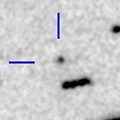
|
Now it is 18.0 mag (Apr. 27, Toshihiko Ikemura, Hirohisa Sato). It brightens up to 18 mag and it is observable in good condition from April to June. It locates somewhat low in the Southern Hemisphere.
Date(TT) R.A. (2000) Decl. Delta r Elong. m1 Best Time(A, h)
May 11 13 56.55 30 16.6 1.938 2.690 128 17.9 22:40 ( 0, 85)
May 18 13 54.08 30 0.5 1.992 2.699 124 17.9 22:11 ( 0, 85)
|

|
Main-belt asteroid. But it shows a straight tail like a comet. Now it is 18.1 mag (May 2, Toshihiko Ikemura, Hirohisa Sato). It stays observable in excellent condition until early summer.
Date(TT) R.A. (2000) Decl. Delta r Elong. m1 Best Time(A, h)
May 11 10 12.24 8 18.4 1.762 2.209 102 18.2 20:29 ( 44, 56)
May 18 10 18.55 8 53.1 1.831 2.193 96 18.2 20:37 ( 54, 52)
|
|
![]()
 A/2017 U7
A/2017 U7 60P/Tsuchinshan 2
60P/Tsuchinshan 2 C/2018 KJ3 ( Lemmon )
C/2018 KJ3 ( Lemmon ) C/2010 U3 ( Boattini )
C/2010 U3 ( Boattini ) 74P/Smirnova-Chernykh
74P/Smirnova-Chernykh 46P/Wirtanen
46P/Wirtanen C/2017 K2 ( PanSTARRS )
C/2017 K2 ( PanSTARRS ) 38P/Stephan-Oterma
38P/Stephan-Oterma P/2018 X1 ( LONEOS )
P/2018 X1 ( LONEOS ) C/2014 B1 ( Schwartz )
C/2014 B1 ( Schwartz ) 260P/McNaught
260P/McNaught 186P/Garradd
186P/Garradd C/2019 F1 ( ATLAS-Africano )
C/2019 F1 ( ATLAS-Africano ) 240P/NEAT
240P/NEAT 149P/Mueller 4
149P/Mueller 4 (6478) Gault
(6478) Gault![]()































